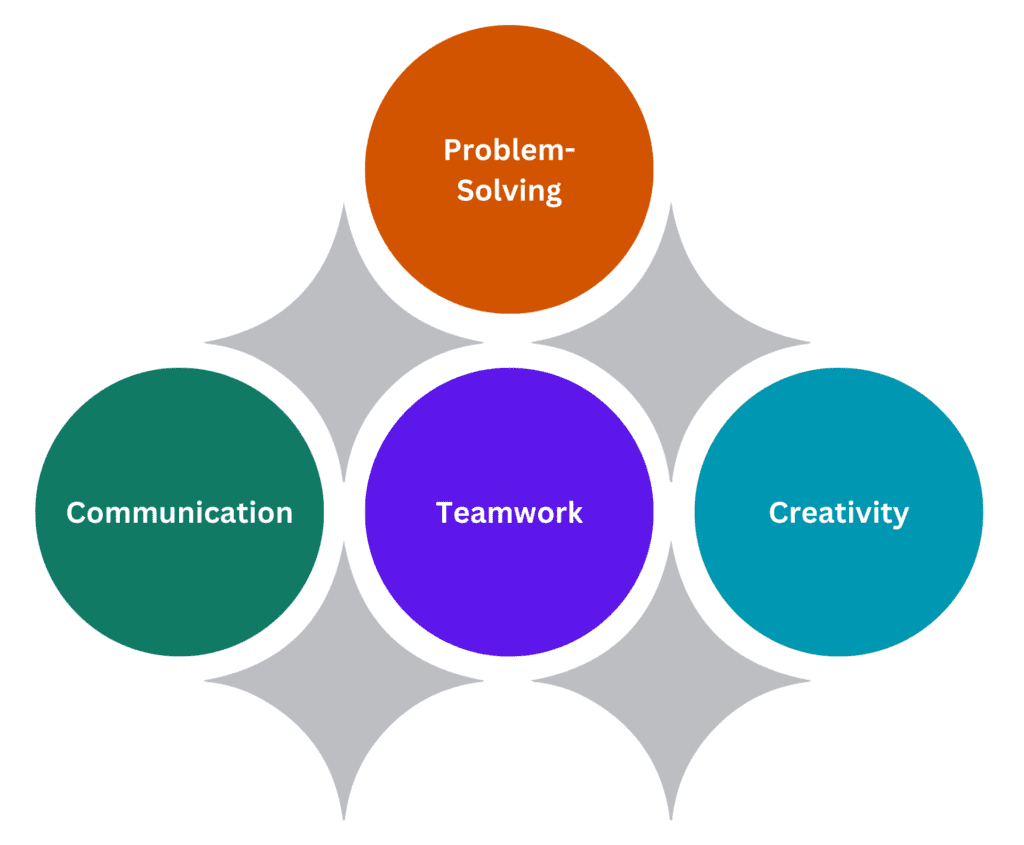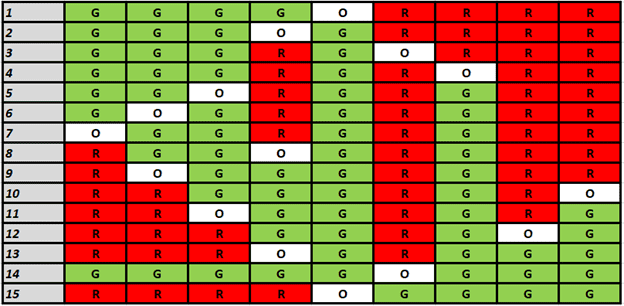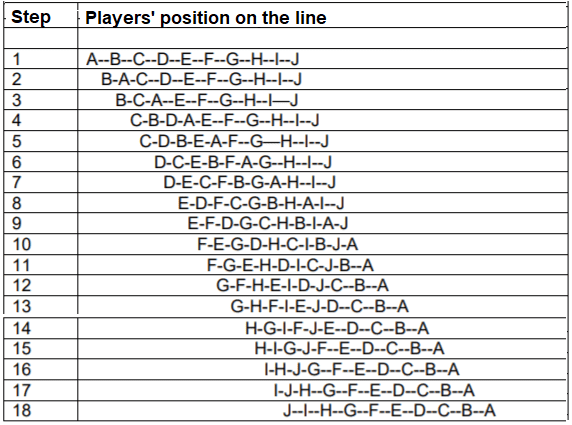
CHAPTER 11
“Everyone complains of his memory, and no one complains of his judgment.”
La Rochefoucauld
Creativity or initiative games develop the logical and creative thinking of the group.
Most of these games involve solving one or more problems, which can only be achieved through collaboration and some physical effort. The educational process based on a problem to be solved can help understand the decision-making process, leadership, obligations, and strengths of each group member. Players solve the problem as a team to leverage the overall physical and mental abilities of their teammates.
These games also help confirm the competence of some students, dispel some widespread preconceived ideas in the social context, build morale, and foster camaraderie.
Sometimes the solution is found by one person alone, while other times it results from the interactive discussions of team members. In both cases, the game requires participants not only to imagine the solution but also to put it into practice. In this way (and with the help of discussion for deciphering), the group learns to produce solutions, either individually or as a group, and then apply them. They will learn that the most efficient way to accomplish a challenging task is through cooperation.
11.1. Person to Person

Materials needed: None.
Game rules: A “caller” is chosen, and the other players pair up, holding hands. The “caller” shouts various commands (for example: knee to knee; or elbows to knees, etc.) and the pairs follow the command. After 2-3 commands, the “caller” shouts “change partners!” and everyone, including themselves, rearranges, holding hands. You must not have the same partner twice (except when the group is very small). Whoever is left without a partner becomes the “caller.”
The “callers” will try to invent new tasks and commands!
Instructions for the instructor: They should participate in the game if the players are an even number.
11.2. Touch the Box

Materials needed: A large plastic bottle, or a large ball, etc.
Game rules: Players gather around the object placed on the ground. The goal is for everyone to touch the object at the same time with a specific part of the body (which is indicated, for example: finger, toe, knee, elbow, shoulder, etc.).
Variations: The group will transport the object, supported by the pressing of the respective body parts of the players, to a predetermined location, situated about 4-6 meters away.
Instructions for the instructor: If the group is too large, it will be divided into smaller groups.
11.3. The Lava Pit

Materials required: 20 large plastic or cardboard plates; adhesive tape.
Game rules: The game will be presented to the players as a desperate attempt to rescue individuals caught in a natural disaster (volcanic eruption). Rescue is achieved by crossing a river of molten lava, with the banks marked on the ground with chalk or coloured adhesive tape, at a considerable distance from each other (10-15 m). Cardboard plates are objects unaffected by the lava’s action. Anyone stepping on a plate neither sinks nor burns. The group receives the “miracle” plates in a number of approximately 1/3 of the total number of players.
The group has to find a solution for everyone to cross from one bank to the other, using the available plates. Only one player can stand on a plate, and the plates can be moved by players to where they are needed for crossing.
Variations: The group is divided into two teams competing against each other against the clock; or attempts are made to beat the “previously set” record for crossing duration.
Instructions for the instructor: Since the number of plates is insufficient to establish a fixed bridge on which the entire group can safely step from one bank to the other, the solution is for one group to cross first, then a player returns to the first bank with the stack of plates, which will be used for the crossing of another group, and so on.
11.4. Balloon Keep-Up

Materials needed: Balloons (1 per 5 players).
Game rules: The group is divided into teams of 4-6 players, each receiving a balloon to inflate. Then, holding hands, the team members form a circle and strive to keep the balloon in the air by hitting it without letting go of their hands. If the balloon touches the ground, the team “loses” the use of their hands initially, meaning they can no longer touch the balloon with their hands. Furthermore, always without letting go of their hands, each time the balloon touches the ground, players “lose” the right to use their elbows, shoulders, heads, or feet.
Variations: The balloon can be kept in the air for a certain duration of time, in a specific location, or the team will transport it from one place to another while keeping it in the air.
11.5. Line Up

Materials needed: Scarves or bandanas for blindfolding.
Game rules: Essentially, the task is for all players to line up along a line (approximately straight) drawn beforehand on the ground, standing, adhering to a predetermined criterion, with their actions being restricted in some way. There are practically numerous variations of the game. Here are some suggestions easily adaptable to the specifics of any group:
- In order of height. All participants are blindfolded and instructed to follow a set of safety rules: to move slowly with hands stretched forward, not to push, to stop immediately when the instructor shouts “stop,” or claps twice, etc. After blindfolding, the rule of lining up is explained: alignment in ascending order of height, with the shortest person at the front and the tallest person at the back.
- In order of birth date. Participants will line up in chronological order of their birth dates (without considering the year), without making any sound or speech, with the person born closest to January 1st at the front.
Variations:
- Players are blindfolded, or not.
- Lining up in a circle.
11.6. Pyramid

Materials needed: None.
Game rules: In 15 seconds, participants must create a pyramid (or triangle) with their bodies.
Variation: Divide the group into two equal teams. Each team must hang a handkerchief as high as possible (on a wall, on a tree), without using any assisting objects to climb (chairs, etc.).
Instructions for the instructor: If they decide on a “vertical” pyramid, safety measures must be organized, with rescuers assigned to support and assist those climbing. Forming a vertical pyramid taller than 3 floors (player bodies) is prohibited. The same applies to the Variation. After the 15 seconds, ask the participants if that was the only possible solution. Was it the simplest? The safest? Can the group find other solutions? (engage in a brainstorming session).
11.7. Traffic Jam

Materials needed: A2-sized cardboard sheets, or squares approximately 50×50 cm.
Game rules: The “traffic” cardboard sheets are placed on the ground in a straight line, so that the number of sheets is equal to the number of players (must be even). Exactly in the middle of them, a “central” cardboard is placed. The arrows drawn on the “traffic” cardboard sheets must point towards the “central” cardboard.
Each player sits on a cardboard with an arrow, facing the “central” cardboard (remaining free), and is required to remain facing the same direction until the end of the game.
The task is for players to swap places, stepping only on the cardboard sheets and keeping their initial facing direction. Movement is only allowed forwards, either onto an unoccupied cardboard or onto an already occupied one, but then it’s mandatory to move onto an unoccupied one next. On the occupied cardboard, passage is made around the other player, who is facing in the opposite direction.
Instructions for the instructor: arranging the cardboard sheets in a semicircle simplifies the problem significantly.
The game in a straight line is quite challenging, and participants may get tangled up. To make it easier, half of them (for example, those facing left) will wear something on their heads (a cap, a bandana, etc.).
Solution: let’s consider a group of 8 players and label the players from the two halves (facing opposite directions) as white (W) and red (R). Here are the moves – see figure 11.1: 1 – the first white player advances onto the central cardboard O (unoccupied). 2,3 – the first red player moves around the white player in front of them and reaches the unoccupied cardboard. 4 – the second red player advances onto the unoccupied cardboard in front of them. 5,6,7 – two white players advance, one after the other, towards the unoccupied cardboard in front of them. 8,9 – two white players advance, one after the other, towards the unoccupied cardboard in front of them. The process continues in the same manner until both groups have swapped places.

11.8. Change Places

Materials needed: None; or a rope.
Game rules: On the ground, a straight line is drawn, or a rope is stretched, along which all players line up in random order, with their soles touching the line, holding hands, and facing in the same direction. The task of the game is for the line of players, led by a “leader” (the person at the left or right end of the line – as indicated by the instructor), to move to the opposite side of the line, while stepping on the line drawn on the ground.
Players can talk, but letting go of hands is not allowed. Anyone’s sole can touch the ground only if it touches the marked line. Violating any rule results in restarting the game from the beginning.

Variants:
- Moving in front of colleagues (face to face);
- Moving behind colleagues (back to back);
- Verbal communication is prohibited;
- To start the game, players line up (hold onto each other in a line) with faces alternately oriented forward and backward.
For other task variants, see #7.8 and #11.5.
11.9. Separation of the Bound

Materials needed: For each player, a piece of thick, coloured rope/cord/strap, approximately 1.5 m in length.
Game rules: Participants form pairs. Each player knots a loop at the ends of their rope (so that hands can enter neither too easily nor too difficultly), then inserts their hands into the resulting loops (they are bound). One of the partners takes one hand out of the loop and passes the loop/end of the rope through the other’s hands, then binds it back in place. In this way, the two partners are “tied” to each other.
Their task/the theme of the game is for the partners to separate without removing their hands from the bindings.
Variants:
- Separation without speaking.
- Separation of partners blindfolded.
- Separation of partners blindfolded and without speaking.
- Repeating the action with changing partners.
- Binding of three or four partners – using three, four, or two ropes (each with four bindings/loops).
- Binding of hands and/or feet – on one/both partners.
- Binding a player already separated to another player/pair.
- Partners stand on either side of a fence (for example, with wire loops) and are bound through a hole in the fence.
Instructions for the instructor:
The game can also be used for getting to know each other, relaxing, communication, etc.

Solution: one of the partners will stand with arms outstretched and palms facing each other. The other player grips their rope halfway along its length and brings the folded part formed close to one of the partner’s palms. Then, they insert the fold under the partner’s rope/shackle (from their elbow), bring it towards the partner’s fingertips, untangle the strands of the rope, and maneuver around the partner’s fingers/hand, then withdraw their hands – and they’re separated!
Generally, no one will succeed in solving the problem. Therefore, after a while, the instructor can show/give advice (or “sell” them – for new problems, for example: I’ll tell you this but then you won’t speak anymore, or close your eyes, etc.). Helpful tips can only be:
- gripping the rope in the middle of its length;
- inserting the fold under the partner’s rope.
Or the instructor will show the solution to a pair, without the other players seeing, after which each of the two will go to other pairs to show them how it’s done. Similarly, other players who manage to separate will go to clarify with the still-bound pairs.
Questions for deciphering: What did you think of the problem? Did you think it would be easy? How can apparently insoluble problems be solved? Which partner contributed more to the solution? Would it have been easier if the ropes were longer? Were you able to help each other?
CONTINUE READING:
Malaysian Guide to Team Building
- CHAPTER 1 : Non-Formal Civic And Entrepreneurial Education
- CHAPTER 2 : The Team Spirit
- CHAPTER 3 : Team Building Education
- CHAPTER 4 : Guidelines for Team Building Instructor
- CHAPTER 5 : Safety & Accident Avoidance
- CHAPTER 6 : Understanding The Experience
- CHAPTER 7 : Introductory Games
- CHAPTER 8 : Warm-up Exercise & Games
- CHAPTER 9 : Calming Games
- CHAPTER 10 : Relaxation Games
- CHAPTER 11 : Creativity Games
- CHAPTER 12 : Cooperation Games
- CHAPTER 13 : Communication Games
- CHAPTER 14 : Trust Games
- CHAPTER 15 : Fun Games
- CHAPTER 16 : Closing Games
- Conclusion
- ANNEX
- Proofreading & Editing


